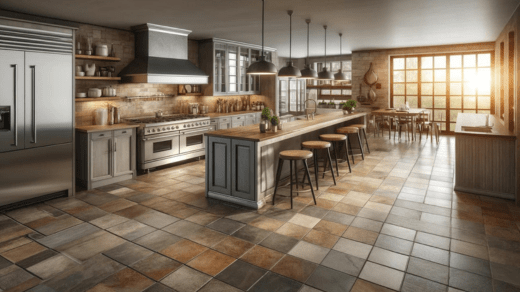
restaurant quarry tiles are recognized
Transform your kitchen with high-quality restaurant quarry tile. Discover durable options for a stylish and functional space today!
In the realm of kitchen flooring, durability and aesthetics are crucial. A material that shines for its resilience and timeless charm is restaurant quarry tile. Initially crafted for heavy-duty use in commercial kitchens, these tiles have found their way into residential spaces, offering homeowners a practical and stylish flooring choice.
Crafted from natural clay and fired at high temperatures, restaurant quarry tiles are recognized for their strength and ability to endure high traffic and spills. Their dense composition makes them resistant to stains, scratches, and moisture, making them an ideal option for busy home kitchens.
Benefits of Using Restaurant Quarry Tile in Your Kitchen
Durability:
One of the main reasons homeowners choose kitchen quarry tile is its exceptional durability. Unlike other flooring materials that may deteriorate over time, restaurant quarry tiles are built to last for decades, making them perfect for the daily demands of a kitchen environment.
Easy Maintenance:
Maintaining industrial kitchen floor tiles is simple. Their non-porous surface prevents liquids and stains from penetrating, allowing for easy cleanup with just a damp mop and mild detergent. This low-maintenance feature is a significant advantage for homeowners looking to keep their kitchens looking pristine with minimal effort.
Timeless Appeal:
With classic earthy tones and rustic textures, restaurant quarry tiles add warmth and character to any kitchen space. Whether you prefer a traditional or modern look, these tiles complement a wide range of interior styles, making them a versatile choice for homeowners seeking a timeless aesthetic.
Choosing the Right Restaurant Quarry Tile for Your Home
When selecting industrial kitchen floor tiles, consider factors such as size, color, and finish to ensure they align with your design preferences and practical needs. Opt for tiles that are at least 1/2 inch thick for enhanced durability and choose a color that complements your kitchen’s color scheme.
Additionally, select a finish that suits your lifestyle. While matte finishes provide a natural look, glossy finishes can add elegance to your kitchen space. Choose tiles that not only enhance the aesthetics of your kitchen but also meet your functional requirements.
Installation Guide: How to Lay Restaurant Quarry Tile Yourself
Installing restaurant quarry tiles can be a rewarding DIY project for homeowners looking to upgrade their kitchen flooring. Here is a step-by-step guide to laying restaurant quarry tile yourself:
Step 1: Prepare the Subfloor
Ensure the subfloor is clean, level, and free of any debris. Apply a thin layer of mortar to create a smooth surface for tile installation.
Step 2: Plan the Layout
Determine the layout of the tiles, ensuring they are evenly spaced and aligned. Use spacers to maintain uniform gaps between the tiles.
Step 3: Apply Adhesive
Spread tile adhesive on the subfloor using a trowel, working in small sections to prevent the adhesive from drying out.
Step 4: Lay the Tiles
Place the tiles firmly into the adhesive, pressing down to ensure they are securely bonded. Use a level to check for evenness.
Step 5: Grout the Tiles
Once the adhesive has set, fill the gaps between the tiles with grout, using a grout float to spread it evenly. Wipe off excess grout with a damp sponge.
Step 6: Seal the Tiles
After the grout has dried, apply a sealant to protect the tiles from stains and moisture, enhancing their longevity.
Maintaining and Cleaning Your Restaurant Quarry Tile Flooring
To maintain the beauty and longevity of your restaurant quarry tile flooring, follow these cleaning and maintenance tips:
Regular Cleaning:
Sweep or vacuum the tiles regularly to remove dirt and debris. Use a damp mop with a mild cleanser to clean the surface and wipe dry to prevent water damage.
Stain Removal:
For stubborn stains, create a paste of baking soda and water and apply it to the stained area. Let it sit for a few minutes before scrubbing gently with a soft brush.
Sealing:
Periodically reseal the tiles to protect them from stains and moisture. Follow the manufacturer’s recommendations for the appropriate sealing products and frequency.
Avoid Harsh Chemicals:
Refrain from using harsh chemicals or abrasive cleaners on the tiles, as they can damage the surface. Stick to mild detergents and natural cleaning solutions to preserve the tiles’ integrity.
Creative Ways to Incorporate Restaurant Quarry Tiles in Kitchen Design
The versatility of restaurant quarry tiles allows for creative design possibilities in kitchen spaces. Here are some innovative ways to incorporate these tiles into your kitchen design:
Statement Backsplash:
Use colorful or patterned quarry tiles to create a striking backsplash that adds visual interest to your kitchen. The unique textures and hues of these tiles can serve as a focal point in the room.
Patterned Floors:
Experiment with different laying patterns, such as herringbone or basketweave, to create a dynamic look on the kitchen floor. Mix and match tile colors to customize the pattern to your liking.
Accent Wall:
Extend quarry tiles beyond the floor and backsplash to create an accent wall in your kitchen. This feature adds depth and texture to the space, elevating the overall design.
Kitchen Island Base:
Wrap the base of your kitchen island with quarry tiles to add a touch of sophistication and protect the island from scuff marks and spills. This design element ties the island seamlessly into the rest of the kitchen.
Comparing Restaurant Quarry Tiles with Other Kitchen Flooring Options
When comparing restaurant quarry tiles with other kitchen flooring options, it’s essential to consider factors such as durability, maintenance, cost, and aesthetics. Here’s how restaurant quarry tiles stack up against popular alternatives:
Porcelain Tile:
Porcelain tiles offer similar durability to quarry tiles but come in a wider range of colors and finishes. However, they may be more expensive than quarry tiles and require professional installation.
Vinyl Flooring:
Vinyl flooring is affordable and easy to maintain, but it may not match the longevity and classic appeal of restaurant quarry tiles. Vinyl is also prone to scratching and fading over time.
Hardwood Flooring:
Hardwood floors exude warmth and elegance but are susceptible to water damage and scratches in a kitchen setting. Restaurant quarry tiles offer better moisture resistance and durability for high-traffic areas.
Laminate Flooring:
Laminate flooring is budget-friendly and easy to install, but it lacks the durability and natural aesthetic of restaurant quarry tiles. Laminate may also be prone to warping and damage from moisture.
In comparison, restaurant quarry tiles strike a balance between durability, aesthetics, and maintenance, making them a practical and stylish choice for kitchen flooring.
Choosing restaurant quarry tiles from reputable manufacturers ensures you receive a high-quality product that enhances the beauty and functionality of your kitchen space.
In conclusion, restaurant quarry tiles offer a winning combination of durability, aesthetics, and practicality for home kitchens. By selecting the right tiles, following proper installation techniques, and maintaining them correctly, you can enjoy a beautiful and long-lasting kitchen flooring solution that stands the test of time. Consider incorporating these versatile tiles into your kitchen design to elevate its style and functionality.







